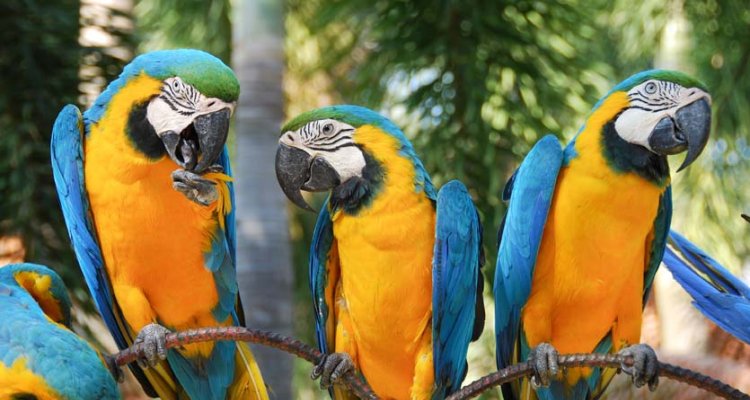
Psittacosis or parrot fever
Psittacosis or parrot fever is a disease that affects humans and psittacines and is also known as ornithosis (in pigeons and poultry). It is caused by the bacterium Chlamydia psittaci. The disease has been described in over 465 bird species and is a zoonosis,which means that it can be transmitted to humans. Wageningen Bioveterinary Research (WBVR) conducts research into this zoonosis.
What causes psittacosis?
Psittacosis is caused by Chlamydia psittaci, a Gram-negative bacterium that replicates in cells in the form of the reticulate body (RB). In the extracellular environment, C. psittaci bacteria survive as elementary bodies (EB). EBs are are non-replicative infectious particles with a spore-like cell wall, which allows them to survive under more harsh environmental conditions.
C. psittaci can be subdivided in at least nine different genotypes (former serotypes) based on the gene sequence coding for an outer membrane protein (ompA, MOMP). The genotypes are associated with different host species. For example, type A is mainly detected in parrots and type B in pigeons. Genotyping can therefore be used in source tracing.
The past ten years several new Chlamydia species have been identified in birds. These include Chlamydia avium in pigeons and parrots, Chlamydia buteonis in birds of prey and Chlamydia gallinacea in poultry. C. avium and C. buteonis can cause similar disease as C. psittaci, but their zoonotic potential has to be further elucidated. C. gallinacea infections are asymptomatic, but reduced weight gain in broilers has been observed. There is currently no evidence that C. gallinacea is zoonotic.
The term avian chlamydiosis is currently considered to be more accurate to describe the disease caused by Chlamydia in birds than psittacosis or ornithosis.
What are the consequences for animals?
The disease mainly occurs in parrots and pigeons. The symptoms include discharge from the eyes and nose, lack of appetite and diarrhoea, and range from extremely mild to severe. Asymptomatic carriers also occur: these are animals that do in fact carry the bacterium but do not show symptoms. However, under conditions of stress or immunosuppression, the birds may become sick and excrete bacteria, which makes them infectious for other birds and for humans. C. psittaci is excreted via faeces and eye and nasal discharges. Diseased birds can be treated with antibiotics. Avian chlamydiosis in pet birds is a notifiable disease in the Netherlands.
What happens when humans are infected?
People usually become infected by inhaling dust contaminated with dried secretions or faeces from infected birds. The severity of human illness ranges from no symptoms, to mild flu-like symptoms or severe pneumonia. Pneumonia is the most well-known manifestation of the disease in humans; if severe, it may require hospitalisation. The disease can be treated effectively with antibiotics, so mortality is low (<1%).
A psittacosis pandemic
Until 1929, psittacosis was virtually unknown, but in the winter of 1929-1930, about 750 to 800 people worldwide became ill from the disease. About 15 percent of them died because no effective treatment with antibiotics was available at that time. The disease spread worldwide due to imports – mostly illegal – of parrots from South America. Parrots had become popular pets around that time.
The worldwide outbreak resulted in stricter rules for importing parrots. Later on, it became clear that other bird species could also transmit the disease to humans. One outcome of the psittacosis pandemic was legislation on controlling psittacosis.
How does Chlamydia psittaci spread?
Psittacosis occurs primarily in birds, the main carriers being psittaciformes (parrot-like birds) and pigeons. Birds may also be asymptomatic carriers, which makes it difficult to distinguish infected birds from uninfected ones. C. psittaci remains infectious in bird faeces for a long time, even when the faeces are dry.
What control measures apply to psittacosis?
Owners of birds kept as pets (with the exception of poultry) that show symptoms of psittacosis are obligated to notify the Dutch Food and Consumer Product Safety Authority (NVWA). If psittacosis is diagnosed, the birds are treated with antibiotics and then tested to determine whether they are free of the disease.
If the disease is diagnosed in humans as shown by a confirmed laboratory test, notification of the appropriate authority (via the GGD) is also mandatory. In those cases, the NVWA will perform source tracing of infected birds.
What tasks does Wageningen Bioveterinary Research perform?
Among other tasks, WBVR performs laboratory diagnostics on samples collected by the NVWA to diagnose infections in animals or trace the source of human infections. For this purpose, faeces or swabs of the conjunctiva, choanae or cloaca are tested.
Diagnosis is based on a PCR test, which detects the DNA of the bacterium. First, a general PCR test is performed that can detect all types of Chlamydia. Subsequently, a second PCR test confirms that it is C. psittaci. In addition, typing (ompA typering) can be performed to determine the specific C. psittaci genotype.
WBVR does not have an antibody test available. WBVR does have the facilities toto culture C. psittaci. This is only performed for research purposes and requires strict safety measures (BSL3).
WBVR, together with partners such as RIVM, Utrecht University and the NVWA, is conducting research into the epidemiology and control of psittacosis. WBVR and its partners also study the role and significance of other Chlamydia species such as C. avium, C. gallinacea and C. caviae. The zoonotic potential of C. caviae is only recently confirmed when transmission of C. caviae from guinea pig to human resulted in severe pneumonia.